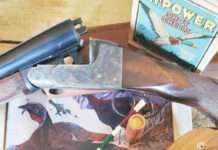Last winter, we took two ewes out of breeding rotation. One was ready for retirement and the other had a case of mastitis that damaged half her udder. While the rest of the flock hung out with the buck in the big corral, those two were let out to free range with the cows. When it was time to pull the buck, they happily rejoined the flock.
The buck was less pleased with his situation and broke out of confinement 147 days ago. How do I know it was 147 days? Because that’s the length of a lamb’s gestation, and this week, during the worst heat wave in recent memory, the two ewes we didn’t want to breed both had babies on the same day — their ovulation clearly the reason that darn buck decided to free himself.
I began to suspect the elderly ewe had a passenger a few weeks ago. She’s a Shetland, and very small, and was definitely sporting a baby bump. But the other ewe, who is a much larger framed breed, didn’t look pregnant at all.
Sure enough, last Wednesday, the man of the ranch texted me a picture of the Shetland and her brand new baby. Thankfully, despite her age, she was doing great, and so was the baby, who, like all Shetlands, was running as soon her hooves hit the ground.
Just after I got the text though, I got a phone call. “There’s a Targhee ewe with a baby too,” my husband said when I answered, “but that one needs your help. The lamb can’t straighten its legs.”
I arrived to find the Targhee mama standing patiently with her new baby. His front legs were bowed outward and bent at the elbows. Upon closer inspection, I saw his lower jaw was significantly bigger than his upper one, giving his snout a truncated appearance. Despite all this, his mama had carefully cleaned him and somehow managed to feed him even though he couldn’t stand upright.
Sometimes lambs are born with tight tendons that make their limbs inflexible, but with time they recover. Looking at this lamb’s malformed jaws, and the extreme angles of his bent elbows, it was clear that was not the case here. He was never going to be able to stand or graze, or do any of the other things that sheep are born to do.
I’ve only had two other obviously deformed babies and both of those were stillborn. And now here was this tiny lamb — a lamb who should never have been conceived — being tenderly cared for by a mother we worried wouldn’t be able to feed a healthy baby, let alone one with extreme disabilities.
It was a miracle, but one I already knew wouldn’t have a happy ending. That night, lying in bed, I prayed whatever needed to happen was as painless and free from suffering as possible.
The next morning, I went to check on the ewe and lamb, and found the lamb dead. His eyes were open and clear, the fleece around his mouth still wet with his mother’s milk. His mother kept nuzzling him gently, trying to wake him up.
We’d left the pair in a small corral next to the rest of the flock, so no one would bother them. Now, I opened the gate to let her leave when she was ready. Almost as soon as I did, two other ewes walked up and began calling to her. It wasn’t long before she followed them out to where the rest of the flock was gathered. She came back once more to see if her baby would wake, then rejoined her friends, leaving her baby’s body to return to the soil.
In one of my earliest columns, I wrote that I believe God can be found in the dirt, where all life begins and ends. I believe God can also be found in the flock, where grief is transmuted across generations, the inevitability of loss absorbed through community and healing found in the simple act of being together.













